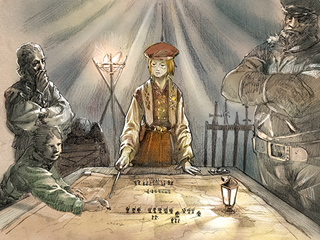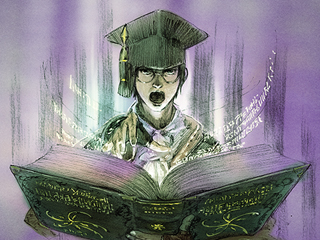Martial Magicians

War is an act in which force is used to attain an objective. If you lose sight of that objective, the force you have mustered will waver.
First, decide your objective. All of your strategies will develop from there.
[From the preface to Theories of War by Gunther Schultz]
There was once a group of academics that earned the respect of all ranks of the allied forces with their ability to lead troops to victory using a combination of shrewd planning and resourceful strategies in their positions as tacticians and military officers. These academics were known as military scholars.
Their characteristic gowns and hats became symbols of their brilliance as they drove the forces of Altana to victory with strategies evolved in the shade of field tents.
The mysteries of the grimoire--the source of a scholar's knowledge--will now be revealed.
The Birth of the Scholar

The ferocious inferno of knowledge that we know as "magic" will soon fall into the hands of both Elvaan and Yagudo alike. On that day, a war that encompasses both man and woman, young and old, will descend upon as all.
I write this tome in the hope that it will aid in the defense of my beloved Windurst. I pray it never falls into the hands of our enemies...
[From the afterword of the grimoire, by Lungo-Nango]
Martial theory is a field of study that is researched through the historical and practical application of battlefield tactics. Though uncommon these days, there was an age when martial theory was so highly regarded that any scholar was automatically considered to be a "military scholar." That age was the Crystal War.
It was plain to even a child's eyes that the early defeats suffered by the allied forces were due to the overwhelming numbers of the beastmen. However, the leaders of the allied nations were also taken aback by the unexpected sophistication of the beastmen's strategies--an entirely new approach was needed.
Military scholars were suddenly thrust onto the center stage of the war, with offers to become tacticians and operations staff flowing in from every allied army. Of particular note were the advocates of the Gunther Schultz School of Martial Theory, who led Bastok's forces to victory in the Second Battle of Konschtat. Their philosophy that action and knowledge were one and the same prepared them with the capability to respond immediately to any situation with which they were presented.
An irreplaceable resource of the proponents of the Schultz School of Martial Theory, the military text known as the "grimoire" is a unique work. The original manuscript was penned on papyrus by the Windurstian Warlock Warlord Lungo-Nango. He professed unfamiliarity with magic, but after researching its strengths and weaknesses, he put forth a series of unconventional strategies that combined frontal magical assaults by heavy Caster Companies with flanking attacks by highly mobile beast units(*). He was a celebrated warlord with victories on many battlefields. However, after his death, the mages of Windurst narrowed their research to the study of pure magic, and Lungo-Nango's brilliant magical, martial tactics were all but forgotten.
Three hundred years later, the scattered pages of Lungo-Nango's works were collected and added to by Gunther Schultz, and thus a revised addition of the grimoire was born. The practice of copying and improving the tome eventually became an unbroken tradition among the pupils of the Schultz School of Martial Theory.
Perfection of the Grimoire

If your enemy is strong, weaken him with dark magic.
If your enemy is weak, attack him with elemental magic.
If your allies are strong, support them with enhancement magic.
If your allies claim victory, prepare them for the next battle with healing magic.
[From the chapter "Military Expeditions," an addition by Adelheid Sturm]
With the musings and records of a hundred years of scholars crammed between its covers, the grimoire had exceeded its original definition as a tactician's manual, and developed into an encyclopedic source of knowledge. The task of memorizing its contents had become a mammoth task for any aspiring scholar, which defeated the Schultz philosophy of practicality and utility. The person to solve this dilemma was none other than Gunther Schultz II, direct descendant of the famous martial theorist himself. Schultz empowered the grimoire with astral properties, enabling the scholar to command the book to disappear and reappear at will. This allowed proponents of the Schultz school to consult the grimoire at any time, significantly expanding their realm of movement. This flexibility would prove invaluable in the time of the Crystal War...
An inquiring mind and boundless curiosity--these are the traits one must possess if one wishes to tread the path of the scholar.
Illustration by Mitsuhiro Arita
*It is theorized that Lungo-Nango possessed the innate qualities of a beastmaster.

War is an act in which force is used to attain an objective. If you lose sight of that objective, the force you have mustered will waver.
First, decide your objective. All of your strategies will develop from there.
[From the preface to Theories of War by Gunther Schultz]
There was once a group of academics that earned the respect of all ranks of the allied forces with their ability to lead troops to victory using a combination of shrewd planning and resourceful strategies in their positions as tacticians and military officers. These academics were known as military scholars.
Their characteristic gowns and hats became symbols of their brilliance as they drove the forces of Altana to victory with strategies evolved in the shade of field tents.
The mysteries of the grimoire--the source of a scholar's knowledge--will now be revealed.
The Birth of the Scholar

The ferocious inferno of knowledge that we know as "magic" will soon fall into the hands of both Elvaan and Yagudo alike. On that day, a war that encompasses both man and woman, young and old, will descend upon as all.
I write this tome in the hope that it will aid in the defense of my beloved Windurst. I pray it never falls into the hands of our enemies...
[From the afterword of the grimoire, by Lungo-Nango]
Martial theory is a field of study that is researched through the historical and practical application of battlefield tactics. Though uncommon these days, there was an age when martial theory was so highly regarded that any scholar was automatically considered to be a "military scholar." That age was the Crystal War.
It was plain to even a child's eyes that the early defeats suffered by the allied forces were due to the overwhelming numbers of the beastmen. However, the leaders of the allied nations were also taken aback by the unexpected sophistication of the beastmen's strategies--an entirely new approach was needed.
Military scholars were suddenly thrust onto the center stage of the war, with offers to become tacticians and operations staff flowing in from every allied army. Of particular note were the advocates of the Gunther Schultz School of Martial Theory, who led Bastok's forces to victory in the Second Battle of Konschtat. Their philosophy that action and knowledge were one and the same prepared them with the capability to respond immediately to any situation with which they were presented.
An irreplaceable resource of the proponents of the Schultz School of Martial Theory, the military text known as the "grimoire" is a unique work. The original manuscript was penned on papyrus by the Windurstian Warlock Warlord Lungo-Nango. He professed unfamiliarity with magic, but after researching its strengths and weaknesses, he put forth a series of unconventional strategies that combined frontal magical assaults by heavy Caster Companies with flanking attacks by highly mobile beast units(*). He was a celebrated warlord with victories on many battlefields. However, after his death, the mages of Windurst narrowed their research to the study of pure magic, and Lungo-Nango's brilliant magical, martial tactics were all but forgotten.
Three hundred years later, the scattered pages of Lungo-Nango's works were collected and added to by Gunther Schultz, and thus a revised addition of the grimoire was born. The practice of copying and improving the tome eventually became an unbroken tradition among the pupils of the Schultz School of Martial Theory.
Perfection of the Grimoire

If your enemy is strong, weaken him with dark magic.
If your enemy is weak, attack him with elemental magic.
If your allies are strong, support them with enhancement magic.
If your allies claim victory, prepare them for the next battle with healing magic.
[From the chapter "Military Expeditions," an addition by Adelheid Sturm]
With the musings and records of a hundred years of scholars crammed between its covers, the grimoire had exceeded its original definition as a tactician's manual, and developed into an encyclopedic source of knowledge. The task of memorizing its contents had become a mammoth task for any aspiring scholar, which defeated the Schultz philosophy of practicality and utility. The person to solve this dilemma was none other than Gunther Schultz II, direct descendant of the famous martial theorist himself. Schultz empowered the grimoire with astral properties, enabling the scholar to command the book to disappear and reappear at will. This allowed proponents of the Schultz school to consult the grimoire at any time, significantly expanding their realm of movement. This flexibility would prove invaluable in the time of the Crystal War...
An inquiring mind and boundless curiosity--these are the traits one must possess if one wishes to tread the path of the scholar.
Illustration by Mitsuhiro Arita
*It is theorized that Lungo-Nango possessed the innate qualities of a beastmaster.














Comment